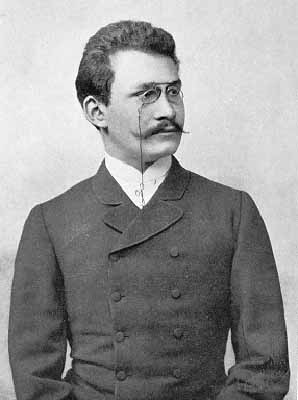 |
|||||||
|
|||||||
|
|
Hermann Minkowski - the man who posed the problem

On September 21, 1908 Hermann Minkowski began his talk at the 80th Assembly of German Natural Scientists and Physicians with the now famous introduction: The views of space and time which I wish to lay before you have sprung from the soil of experimental physics, and therein lies their strength. They are radical. Henceforth space by itself, and time by itself, are doomed to fade away into mere shadows, and only a kind of union of the two will preserve an independent reality. [1, p. 75] Since then the question of the ontological status of this union of space and time has become the subject of a continued debate. It seems Minkowski believed the theory of relativity implied that our world and all objects are four-dimensional (4D) since he introduced the unification of space and time into an indivisible 4D entity (which he called "the World") in a rather substantival manner:
A point of space at a point of time, that is, a system of values, x, y, x, t, I will call a world-point. The multiplicity of all thinkable x, y, x, t systems of values we will christen the world... Not to leave a yawning void anywhere, we will imagine that everywhere and everywhen there is something perceptible. To avoid saying "matter" or "electricity" I will use for this something the word "substance". We fix our attention on the substantial point which is at the world-point x, y, x, t, and imagine that we are able to recognize this substantial point at any other time. Let the variations dx, dy, dz of the space co-ordinates of this substantial point correspond to a time element dt. Then we obtain, as an image, so to speak, of the everlasting career of the substantial point, a curve in the world, a world-line, the points of which can be referred unequivocally to the parameter t from - oo to + oo. The whole universe is seen to resolve itself into similar world-lines, and I would fain anticipate myself by saying that in my opinion physical laws might find their most perfect expression as reciprocal relation, between these world-lines. [1, p. 76] As the union of space and time is, according to Minkowski, a 4D world (or what we now call Minkowski spacetime) the question of its ontological status appears to be: "Is Minkowski spacetime nothing more than a 4D mathematical space which represents an evolving in time 3D world or a mathematical model of a 4D world with time as the forth dimension?" In other words, the issue of the nature of Minkowski spacetime is equivalent to the issue of the dimensionality of the world - whether the world is 3D or 4D. However, not all agree with such a formulation of the question of the ontological status of Minkowski spacetime. Since there are physicists and philosophers of science who think the 3D/4D debate does not reflect a real problem, here are the reasons of those who believe it does. Let us start with two explicit assumptions:
It is clear that the pre-relativistic view, in which existence is considered absolute (observer- or frame-independent), contradicts relativity since the present (all events occurring simultaneously at the moment "now") implies absolute simultaneity. There appear to be only two possible ways to avoid the contradiction: (i) preserving the absoluteness of existence but giving up the three-dimensionality of the world (in this case reality, whose existence is absolute, is 4D and is represented by Minkowski [or other relativistic] spacetime), and (ii) preserving the three-dimensionality of the world but giving up the absoluteness of existence (in this case reality is 3D whose existence is relativized – observer- or frame-dependent). A 3D world requires not only a relativization of existence, but also a pre-relativistic division of events into past, present, and future. Therefore, it appears that such a world view may not be consistent with relativity. However, the alternative view – reality is a 4D world with time entirely given as the forth dimension – implies that there is (i) no objective time flow (since all events of spacetime are equally existent), (ii) absolute determinism (at the macro scale), and (iii) no free will. It is precisely these consequences of the 4D world view that make most physicists and philosophers agree that a world view leading to such implications must be undoubtedly wrong. But so far, after so many years of debate, no one has succeeded in formulating a view that avoids the above dilemma and is compatible with relativity. V. P.
References
|
||||||